Experimental Analysis of Heat Loss in Air Conditioning Ducts
VerifiedAdded on 2023/06/05
|20
|4159
|473
Practical Assignment
AI Summary
This practical assignment focuses on analyzing heat loss in air conditioning duct systems through experimental methods and calculations. The study determines heat loss between different temperature points (T2-T4 and T4-T5) in Test A, finding values of 7.4554 J and 6.7157 J for the first 40% and second 60% of the preheater's relative power, respectively. Test B showed higher heat loss due to greater temperature changes, with heat loss between T5-T1 and T4-T5 calculated as 14.1716 J and 14.9326 J for the first 40% and 14.133 J and 14.94733 J for the second 60% of the preheater's relative power, respectively. Additionally, the power dissipated by the preheater was calculated for both tests. The assignment also covers duct system performance criteria, fan laws, methodology, equipment, and procedures used in the experiment. Desklib offers a range of resources, including past papers and solved assignments, to support students in their studies.

Abstract
The results from the calculation showed that in test A the heat loss between temperature T2 and
T4 together with the calculation of the heat loss between temperature T4 and T5 where all
determined and found to be 7.4554 J and 6.7157 J and 7.4526 J and 6.7111 J at the first 40% of
the relative power of preheater and the second 60% of the relative power of preheater
respectively
The comparison on the heat loss between test A and B showed that heat loss in test B were
higher than those that were calculated in test A, because of a higher change in temperature in test
B.
In addition, the calculated heat loss in test B between temperature T5 and T1 and also calculation
of heat loss between temperature T4 and T5 were determined to be 14.1716 J and 14.9326 J and
14.133 J and 14.94733 J at the first 40% of the relative power of preheater and the second 60%
of the relative power of preheater respectively.
Furthermore, the calculation of power dissipated by the preheater was also determined in test A
between the temperature T1 and T2 as 7.4571 W for the first 40% of the relative power of
preheater and 6.706 W for the second 60% of the relative power of preheater, similarly in test B
between the temperature T1 and T2 as 14.179 W for the first 40% of the relative power of
preheater and 14.946 W for the second 60% of the relative power of preheater.
The results from the calculation showed that in test A the heat loss between temperature T2 and
T4 together with the calculation of the heat loss between temperature T4 and T5 where all
determined and found to be 7.4554 J and 6.7157 J and 7.4526 J and 6.7111 J at the first 40% of
the relative power of preheater and the second 60% of the relative power of preheater
respectively
The comparison on the heat loss between test A and B showed that heat loss in test B were
higher than those that were calculated in test A, because of a higher change in temperature in test
B.
In addition, the calculated heat loss in test B between temperature T5 and T1 and also calculation
of heat loss between temperature T4 and T5 were determined to be 14.1716 J and 14.9326 J and
14.133 J and 14.94733 J at the first 40% of the relative power of preheater and the second 60%
of the relative power of preheater respectively.
Furthermore, the calculation of power dissipated by the preheater was also determined in test A
between the temperature T1 and T2 as 7.4571 W for the first 40% of the relative power of
preheater and 6.706 W for the second 60% of the relative power of preheater, similarly in test B
between the temperature T1 and T2 as 14.179 W for the first 40% of the relative power of
preheater and 14.946 W for the second 60% of the relative power of preheater.
Paraphrase This Document
Need a fresh take? Get an instant paraphrase of this document with our AI Paraphraser

Introduction
The main objective of air conditioning duct involves supplying air of specified rate to all
required point and its operation together with installation based on its initial cost and cost of the
operating fan should be economical, furthermore, the air conditioning duct system should work
efficiency with no noise productions. The calculation of rate of air flow is determined through
load calculations,
The ducts are designed based on the following criteria;
1. The supply of air should be direct in order create space, save on power and also material.
2. Instantaneous changes in the flow of air should be avoided in order to lower pressure loss
3. Consideration should be done on divergent sections or areas by ensuring they are gradual
4. The ratio of aspect should be approximately 1.0
5. The velocity of air should lie within permissible limit in order to avoid noise production.
Duct system performance
Fans:
Fan is an fundamental component of the air conditioning system, therefore a great consideration
should always be taken into account for the design of the whole system of the air conditioning,
the recommended type of fan to be used is the centrifugal fun since its capable of moving large
amount of air at all level of pressure ranges.
Fan laws:
The fan laws are a group of relations that are used to predict the effect of change of operating
parameters of the fan on its performance. The fan laws are valid for fans, which are
geometrically and dynamically similar. The fan laws have great practical use, as it is not
economically feasible to test fans of all sizes under all possible conditions.
The parameters of a fixed diameter fans
1. air density which is dependable on pressure and temperature
2. the operational speed of the fan
3. the fan size
The main objective of air conditioning duct involves supplying air of specified rate to all
required point and its operation together with installation based on its initial cost and cost of the
operating fan should be economical, furthermore, the air conditioning duct system should work
efficiency with no noise productions. The calculation of rate of air flow is determined through
load calculations,
The ducts are designed based on the following criteria;
1. The supply of air should be direct in order create space, save on power and also material.
2. Instantaneous changes in the flow of air should be avoided in order to lower pressure loss
3. Consideration should be done on divergent sections or areas by ensuring they are gradual
4. The ratio of aspect should be approximately 1.0
5. The velocity of air should lie within permissible limit in order to avoid noise production.
Duct system performance
Fans:
Fan is an fundamental component of the air conditioning system, therefore a great consideration
should always be taken into account for the design of the whole system of the air conditioning,
the recommended type of fan to be used is the centrifugal fun since its capable of moving large
amount of air at all level of pressure ranges.
Fan laws:
The fan laws are a group of relations that are used to predict the effect of change of operating
parameters of the fan on its performance. The fan laws are valid for fans, which are
geometrically and dynamically similar. The fan laws have great practical use, as it is not
economically feasible to test fans of all sizes under all possible conditions.
The parameters of a fixed diameter fans
1. air density which is dependable on pressure and temperature
2. the operational speed of the fan
3. the fan size
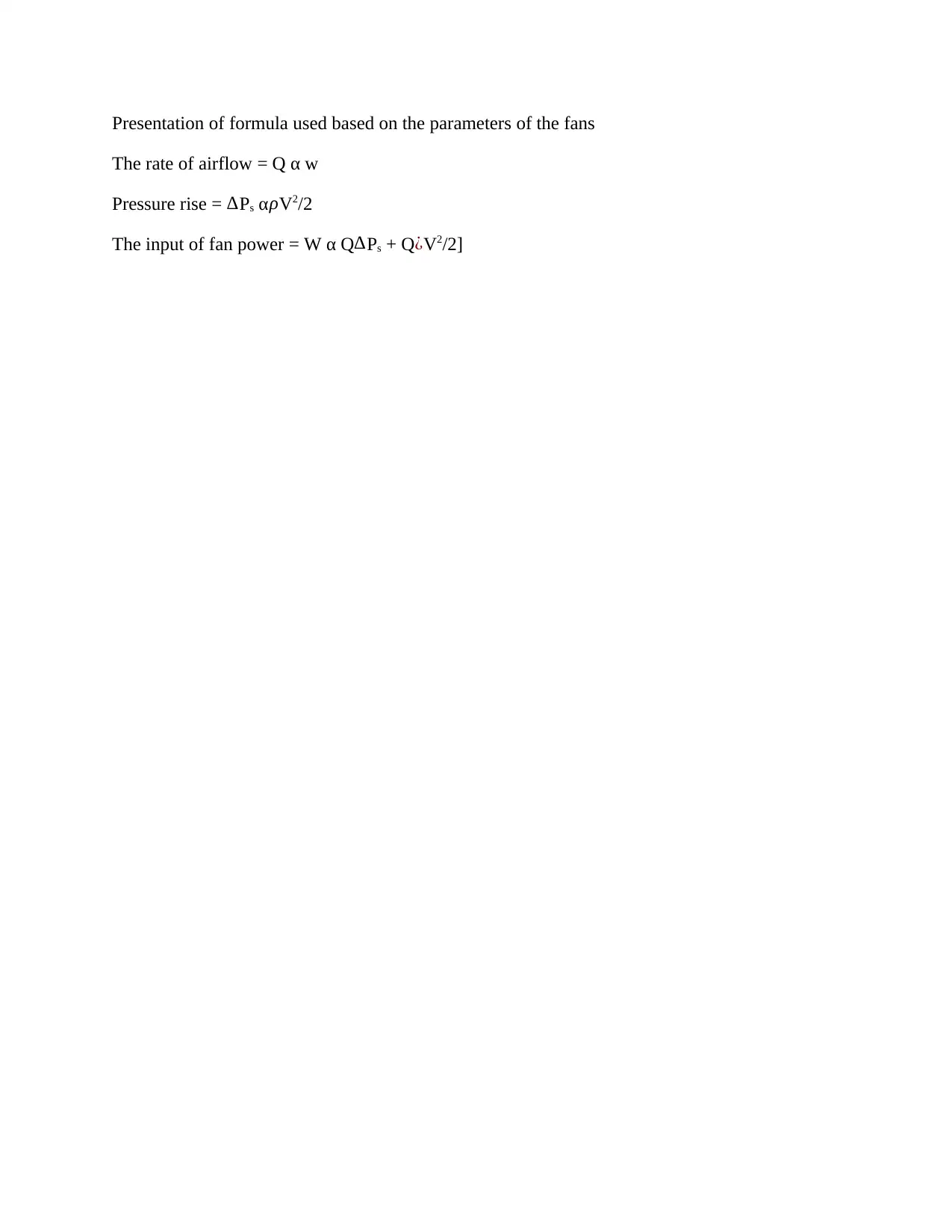
Presentation of formula used based on the parameters of the fans
The rate of airflow = Q α w
Pressure rise = ∆Ps αρV2/2
The input of fan power = W α Q∆Ps + Q¿V2/2]
The rate of airflow = Q α w
Pressure rise = ∆Ps αρV2/2
The input of fan power = W α Q∆Ps + Q¿V2/2]
⊘ This is a preview!⊘
Do you want full access?
Subscribe today to unlock all pages.

Trusted by 1+ million students worldwide

Methodology
Equipment required
Recirculating duct, preheater and reheater, velocity meter, a room model, five temperature
sensors (T1 to T5), sensors RH1 to RH5 and three louvres.
Procedure
The cooling air is directed to the compressor in its state classified as a gas of low pressure, the
compressor role will be to squeeze the air making the air molecules compact together and in the
process of compression there will be a rise in energy used and temperature.
The fluid will exit the compressor in a state of being hot gas, having high pressure and will be
directed to the condenser, which has fins attached on it at its outer surface, on its rotation it
dissipate heat from the fluid, at this point when the fluid will exit from the condenser it state will
be cool fluid, and will change from gas to liquid this is due to higher pressure, the liquid will
make its way to the evaporator through a narrow hole, on its passage at this section the pressure
lowers and in the process the fluid will start changing its state to gas, and in the process the heat
will be drawn from the surrounding air, the heat is required to expand the compact molecules of
liquid to convert its state to gas, the preheater also help in supply the surrounding air with its
thermal energy.
In the process of the refrigerant leaving the section of the evaporator it will be in a state of
having a low pressure, the process will commence once again when it will go back to the
compressor.
The air condenser absorbs the air into the ducts through the vents, the air will be used to cool to
cool the gas in the evaporator, and in the process of removing heat from the air it will be cooled,
the duct will then supply the air back into the room.
The process of supply cold air to the room will be continuous until the air inside your room will
reach a desired temperature. It should be noted the work of a thermostat sensor is to sense that
the temperature inside the room as reached a desired level in order for it to automatically shut
down the air conditioner, in the process of the temperature raising again in the room the
thermostat will sense and starts the air conditioner on again and the process will continue again
until, an ambient temperature will be achieved once again.
Equipment required
Recirculating duct, preheater and reheater, velocity meter, a room model, five temperature
sensors (T1 to T5), sensors RH1 to RH5 and three louvres.
Procedure
The cooling air is directed to the compressor in its state classified as a gas of low pressure, the
compressor role will be to squeeze the air making the air molecules compact together and in the
process of compression there will be a rise in energy used and temperature.
The fluid will exit the compressor in a state of being hot gas, having high pressure and will be
directed to the condenser, which has fins attached on it at its outer surface, on its rotation it
dissipate heat from the fluid, at this point when the fluid will exit from the condenser it state will
be cool fluid, and will change from gas to liquid this is due to higher pressure, the liquid will
make its way to the evaporator through a narrow hole, on its passage at this section the pressure
lowers and in the process the fluid will start changing its state to gas, and in the process the heat
will be drawn from the surrounding air, the heat is required to expand the compact molecules of
liquid to convert its state to gas, the preheater also help in supply the surrounding air with its
thermal energy.
In the process of the refrigerant leaving the section of the evaporator it will be in a state of
having a low pressure, the process will commence once again when it will go back to the
compressor.
The air condenser absorbs the air into the ducts through the vents, the air will be used to cool to
cool the gas in the evaporator, and in the process of removing heat from the air it will be cooled,
the duct will then supply the air back into the room.
The process of supply cold air to the room will be continuous until the air inside your room will
reach a desired temperature. It should be noted the work of a thermostat sensor is to sense that
the temperature inside the room as reached a desired level in order for it to automatically shut
down the air conditioner, in the process of the temperature raising again in the room the
thermostat will sense and starts the air conditioner on again and the process will continue again
until, an ambient temperature will be achieved once again.
Paraphrase This Document
Need a fresh take? Get an instant paraphrase of this document with our AI Paraphraser
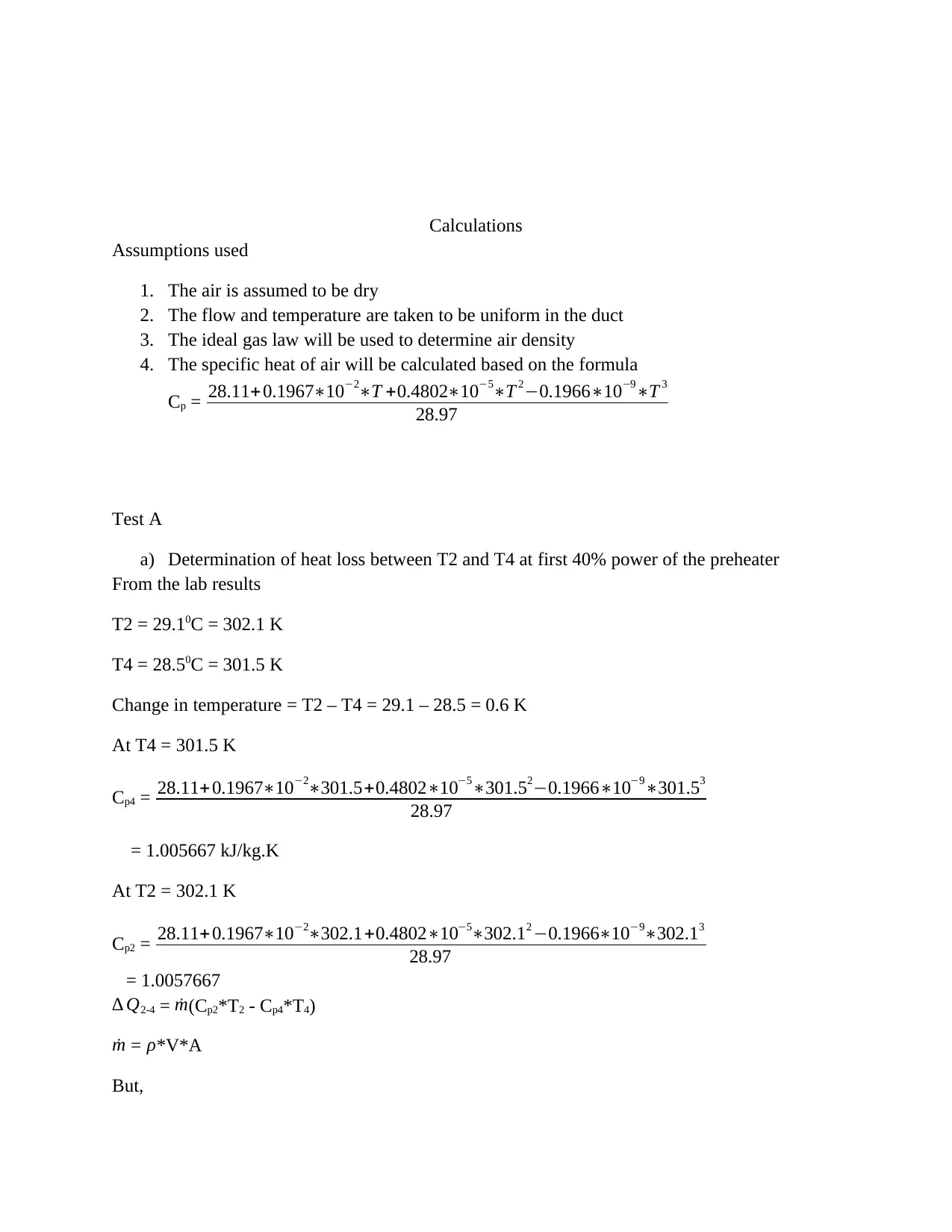
Calculations
Assumptions used
1. The air is assumed to be dry
2. The flow and temperature are taken to be uniform in the duct
3. The ideal gas law will be used to determine air density
4. The specific heat of air will be calculated based on the formula
Cp = 28.11+0.1967∗10−2∗T +0.4802∗10−5∗T 2−0.1966∗10−9∗T 3
28.97
Test A
a) Determination of heat loss between T2 and T4 at first 40% power of the preheater
From the lab results
T2 = 29.10C = 302.1 K
T4 = 28.50C = 301.5 K
Change in temperature = T2 – T4 = 29.1 – 28.5 = 0.6 K
At T4 = 301.5 K
Cp4 = 28.11+0.1967∗10−2∗301.5+0.4802∗10−5∗301.52−0.1966∗10−9∗301.53
28.97
= 1.005667 kJ/kg.K
At T2 = 302.1 K
Cp2 = 28.11+ 0.1967∗10−2∗302.1+0.4802∗10−5∗302.12 −0.1966∗10−9∗302.13
28.97
= 1.0057667
∆ Q2-4 = ˙m(Cp2*T2 - Cp4*T4)
˙m = ρ*V*A
But,
Assumptions used
1. The air is assumed to be dry
2. The flow and temperature are taken to be uniform in the duct
3. The ideal gas law will be used to determine air density
4. The specific heat of air will be calculated based on the formula
Cp = 28.11+0.1967∗10−2∗T +0.4802∗10−5∗T 2−0.1966∗10−9∗T 3
28.97
Test A
a) Determination of heat loss between T2 and T4 at first 40% power of the preheater
From the lab results
T2 = 29.10C = 302.1 K
T4 = 28.50C = 301.5 K
Change in temperature = T2 – T4 = 29.1 – 28.5 = 0.6 K
At T4 = 301.5 K
Cp4 = 28.11+0.1967∗10−2∗301.5+0.4802∗10−5∗301.52−0.1966∗10−9∗301.53
28.97
= 1.005667 kJ/kg.K
At T2 = 302.1 K
Cp2 = 28.11+ 0.1967∗10−2∗302.1+0.4802∗10−5∗302.12 −0.1966∗10−9∗302.13
28.97
= 1.0057667
∆ Q2-4 = ˙m(Cp2*T2 - Cp4*T4)
˙m = ρ*V*A
But,
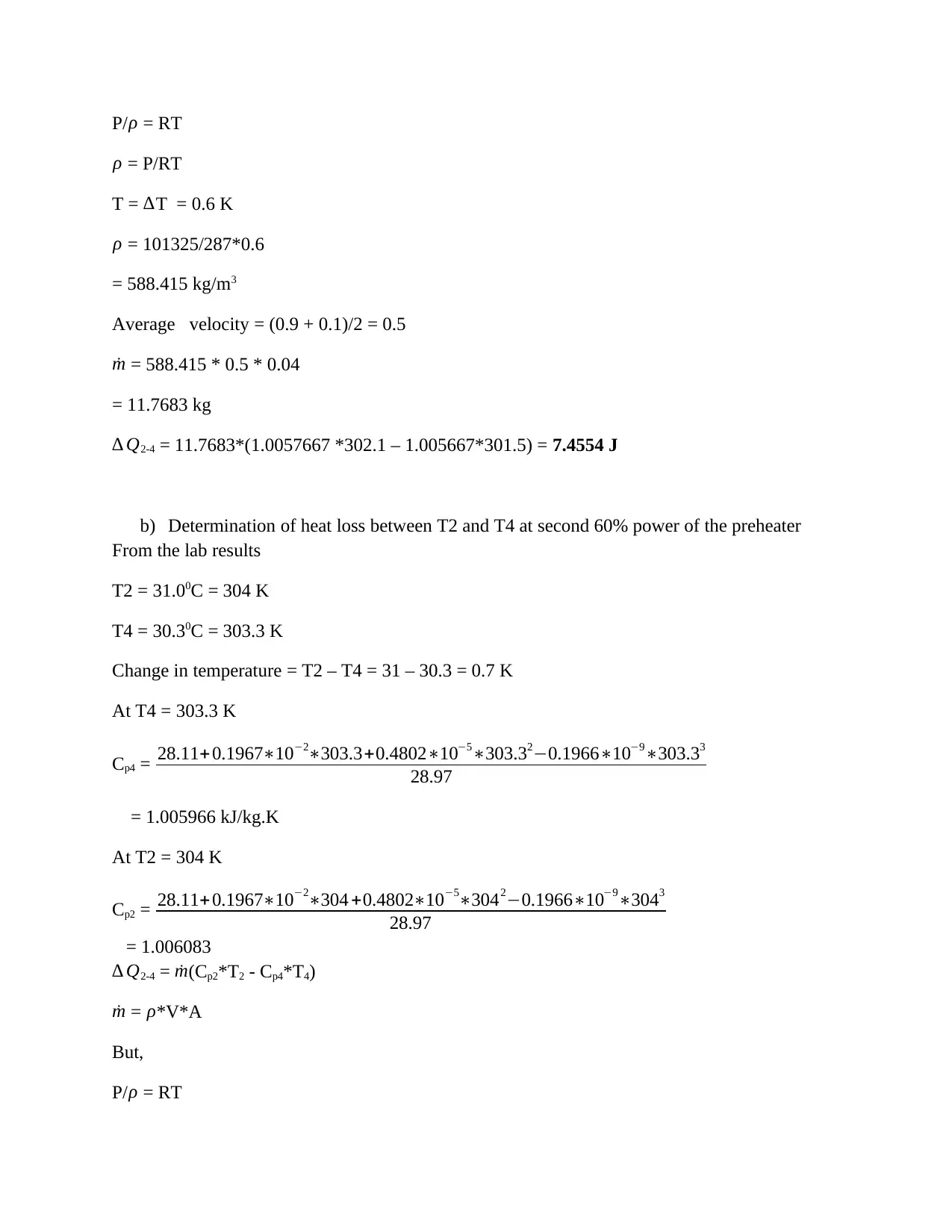
P/ρ = RT
ρ = P/RT
T = ∆T = 0.6 K
ρ = 101325/287*0.6
= 588.415 kg/m3
Average velocity = (0.9 + 0.1)/2 = 0.5
˙m = 588.415 * 0.5 * 0.04
= 11.7683 kg
∆ Q2-4 = 11.7683*(1.0057667 *302.1 – 1.005667*301.5) = 7.4554 J
b) Determination of heat loss between T2 and T4 at second 60% power of the preheater
From the lab results
T2 = 31.00C = 304 K
T4 = 30.30C = 303.3 K
Change in temperature = T2 – T4 = 31 – 30.3 = 0.7 K
At T4 = 303.3 K
Cp4 = 28.11+0.1967∗10−2∗303.3+0.4802∗10−5∗303.32−0.1966∗10−9∗303.33
28.97
= 1.005966 kJ/kg.K
At T2 = 304 K
Cp2 = 28.11+0.1967∗10−2∗304 +0.4802∗10−5∗3042−0.1966∗10−9∗3043
28.97
= 1.006083
∆ Q2-4 = ˙m(Cp2*T2 - Cp4*T4)
˙m = ρ*V*A
But,
P/ρ = RT
ρ = P/RT
T = ∆T = 0.6 K
ρ = 101325/287*0.6
= 588.415 kg/m3
Average velocity = (0.9 + 0.1)/2 = 0.5
˙m = 588.415 * 0.5 * 0.04
= 11.7683 kg
∆ Q2-4 = 11.7683*(1.0057667 *302.1 – 1.005667*301.5) = 7.4554 J
b) Determination of heat loss between T2 and T4 at second 60% power of the preheater
From the lab results
T2 = 31.00C = 304 K
T4 = 30.30C = 303.3 K
Change in temperature = T2 – T4 = 31 – 30.3 = 0.7 K
At T4 = 303.3 K
Cp4 = 28.11+0.1967∗10−2∗303.3+0.4802∗10−5∗303.32−0.1966∗10−9∗303.33
28.97
= 1.005966 kJ/kg.K
At T2 = 304 K
Cp2 = 28.11+0.1967∗10−2∗304 +0.4802∗10−5∗3042−0.1966∗10−9∗3043
28.97
= 1.006083
∆ Q2-4 = ˙m(Cp2*T2 - Cp4*T4)
˙m = ρ*V*A
But,
P/ρ = RT
⊘ This is a preview!⊘
Do you want full access?
Subscribe today to unlock all pages.

Trusted by 1+ million students worldwide

ρ = P/RT
T = ∆T = 0.7 K
ρ = 101325/287*0.7
= 504.355 kg/m3
Average velocity = (0.8 + 0.1)/2 = 0.45
˙m = 504.355 * 0.45 * 0.04
= 6.7157 kg
∆ Q2-4 = 6.7157*(1.006083 *304 – 1.005966*303.3) = 6.7157 J
c) From the calculation it is clearly shown that an increase in the temperature T2 in
the air conditioning cooling system unit will result to an increase in the heat loss,
this is because of higher change in temperature, and it is also known that the change
in temperature is directly proportion to heat loss, based on the formula used in the
calculation.
d) Determination of heat loss between T4 and T5 at first 40% power of the preheater
From the lab results
T5 = 27.30C = 300.3 K
T4 = 28.50C = 301.5 K
Change in temperature = T4 – T5 = 28.5 – 27.3 = 1.2 K
At T4 = 301.5 K
Cp4 = 28.11+0.1967∗10−2∗301.5+0.4802∗10−5∗301.52−0.1966∗10−9∗301.53
28.97
= 1.005667 kJ/kg.K
At T5 = 300.3
Cp5 = 28.11+0.1967∗10−2∗300.3+0.4802∗10−5∗300.32−0.1966∗10−9∗300.33
28.97
= 1.005468
∆ Q2-4 = ˙m(Cp2*T2 - Cp4*T4)
˙m = ρ*V*A
T = ∆T = 0.7 K
ρ = 101325/287*0.7
= 504.355 kg/m3
Average velocity = (0.8 + 0.1)/2 = 0.45
˙m = 504.355 * 0.45 * 0.04
= 6.7157 kg
∆ Q2-4 = 6.7157*(1.006083 *304 – 1.005966*303.3) = 6.7157 J
c) From the calculation it is clearly shown that an increase in the temperature T2 in
the air conditioning cooling system unit will result to an increase in the heat loss,
this is because of higher change in temperature, and it is also known that the change
in temperature is directly proportion to heat loss, based on the formula used in the
calculation.
d) Determination of heat loss between T4 and T5 at first 40% power of the preheater
From the lab results
T5 = 27.30C = 300.3 K
T4 = 28.50C = 301.5 K
Change in temperature = T4 – T5 = 28.5 – 27.3 = 1.2 K
At T4 = 301.5 K
Cp4 = 28.11+0.1967∗10−2∗301.5+0.4802∗10−5∗301.52−0.1966∗10−9∗301.53
28.97
= 1.005667 kJ/kg.K
At T5 = 300.3
Cp5 = 28.11+0.1967∗10−2∗300.3+0.4802∗10−5∗300.32−0.1966∗10−9∗300.33
28.97
= 1.005468
∆ Q2-4 = ˙m(Cp2*T2 - Cp4*T4)
˙m = ρ*V*A
Paraphrase This Document
Need a fresh take? Get an instant paraphrase of this document with our AI Paraphraser
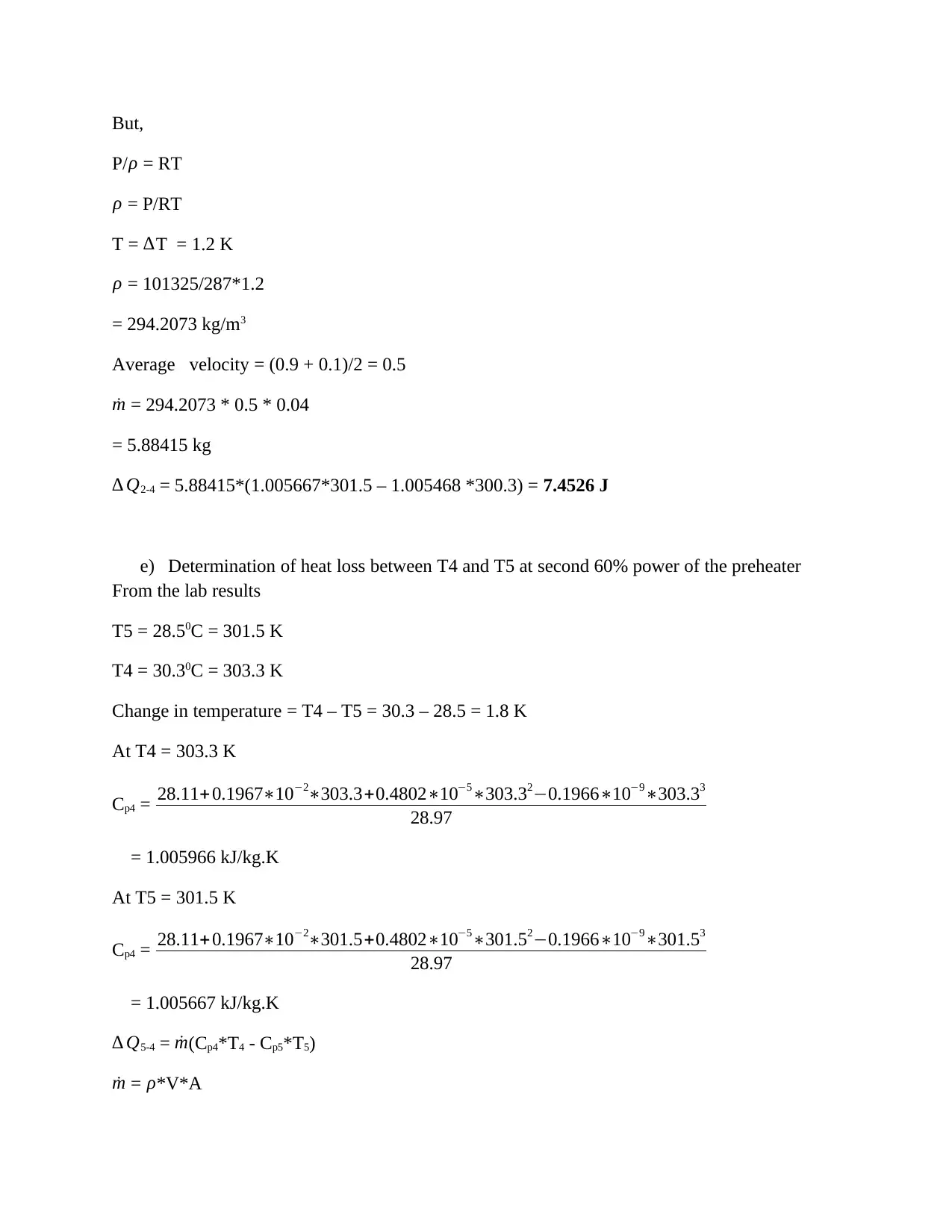
But,
P/ ρ = RT
ρ = P/RT
T = ∆T = 1.2 K
ρ = 101325/287*1.2
= 294.2073 kg/m3
Average velocity = (0.9 + 0.1)/2 = 0.5
˙m = 294.2073 * 0.5 * 0.04
= 5.88415 kg
∆ Q2-4 = 5.88415*(1.005667*301.5 – 1.005468 *300.3) = 7.4526 J
e) Determination of heat loss between T4 and T5 at second 60% power of the preheater
From the lab results
T5 = 28.50C = 301.5 K
T4 = 30.30C = 303.3 K
Change in temperature = T4 – T5 = 30.3 – 28.5 = 1.8 K
At T4 = 303.3 K
Cp4 = 28.11+0.1967∗10−2∗303.3+0.4802∗10−5∗303.32−0.1966∗10−9∗303.33
28.97
= 1.005966 kJ/kg.K
At T5 = 301.5 K
Cp4 = 28.11+0.1967∗10−2∗301.5+0.4802∗10−5∗301.52−0.1966∗10−9∗301.53
28.97
= 1.005667 kJ/kg.K
∆ Q5-4 = ˙m(Cp4*T4 - Cp5*T5)
˙m = ρ*V*A
P/ ρ = RT
ρ = P/RT
T = ∆T = 1.2 K
ρ = 101325/287*1.2
= 294.2073 kg/m3
Average velocity = (0.9 + 0.1)/2 = 0.5
˙m = 294.2073 * 0.5 * 0.04
= 5.88415 kg
∆ Q2-4 = 5.88415*(1.005667*301.5 – 1.005468 *300.3) = 7.4526 J
e) Determination of heat loss between T4 and T5 at second 60% power of the preheater
From the lab results
T5 = 28.50C = 301.5 K
T4 = 30.30C = 303.3 K
Change in temperature = T4 – T5 = 30.3 – 28.5 = 1.8 K
At T4 = 303.3 K
Cp4 = 28.11+0.1967∗10−2∗303.3+0.4802∗10−5∗303.32−0.1966∗10−9∗303.33
28.97
= 1.005966 kJ/kg.K
At T5 = 301.5 K
Cp4 = 28.11+0.1967∗10−2∗301.5+0.4802∗10−5∗301.52−0.1966∗10−9∗301.53
28.97
= 1.005667 kJ/kg.K
∆ Q5-4 = ˙m(Cp4*T4 - Cp5*T5)
˙m = ρ*V*A

But,
P/ ρ = RT
ρ = P/RT
T = ∆T = 1.8 K
ρ = 101325/287*1.8
= 196.138 kg/m3
Average velocity = (0.98+ 0.1)/2 = 0.45
˙m = 252.178 * 0.45 * 0.04
= 3.530487 kg
∆ Q2-4 = 3.53048*( 1.005966*303.3 – 1.005667 *301.5) = 6.7111 J
P/ ρ = RT
ρ = P/RT
T = ∆T = 1.8 K
ρ = 101325/287*1.8
= 196.138 kg/m3
Average velocity = (0.98+ 0.1)/2 = 0.45
˙m = 252.178 * 0.45 * 0.04
= 3.530487 kg
∆ Q2-4 = 3.53048*( 1.005966*303.3 – 1.005667 *301.5) = 6.7111 J
⊘ This is a preview!⊘
Do you want full access?
Subscribe today to unlock all pages.

Trusted by 1+ million students worldwide
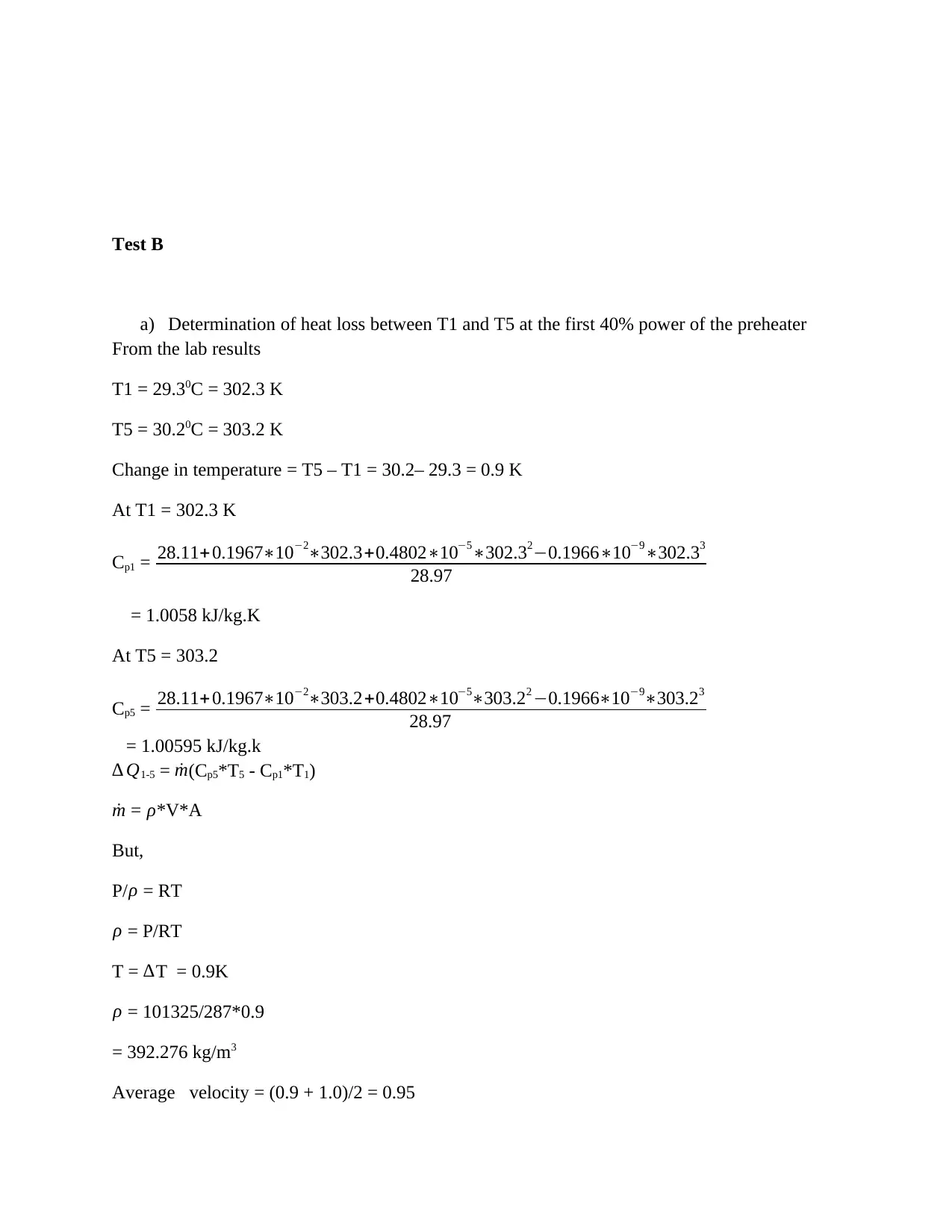
Test B
a) Determination of heat loss between T1 and T5 at the first 40% power of the preheater
From the lab results
T1 = 29.30C = 302.3 K
T5 = 30.20C = 303.2 K
Change in temperature = T5 – T1 = 30.2– 29.3 = 0.9 K
At T1 = 302.3 K
Cp1 = 28.11+0.1967∗10−2∗302.3+0.4802∗10−5∗302.32−0.1966∗10−9∗302.33
28.97
= 1.0058 kJ/kg.K
At T5 = 303.2
Cp5 = 28.11+ 0.1967∗10−2∗303.2+0.4802∗10−5∗303.22 −0.1966∗10−9∗303.23
28.97
= 1.00595 kJ/kg.k
∆ Q1-5 = ˙m(Cp5*T5 - Cp1*T1)
˙m = ρ*V*A
But,
P/ ρ = RT
ρ = P/RT
T = ∆T = 0.9K
ρ = 101325/287*0.9
= 392.276 kg/m3
Average velocity = (0.9 + 1.0)/2 = 0.95
a) Determination of heat loss between T1 and T5 at the first 40% power of the preheater
From the lab results
T1 = 29.30C = 302.3 K
T5 = 30.20C = 303.2 K
Change in temperature = T5 – T1 = 30.2– 29.3 = 0.9 K
At T1 = 302.3 K
Cp1 = 28.11+0.1967∗10−2∗302.3+0.4802∗10−5∗302.32−0.1966∗10−9∗302.33
28.97
= 1.0058 kJ/kg.K
At T5 = 303.2
Cp5 = 28.11+ 0.1967∗10−2∗303.2+0.4802∗10−5∗303.22 −0.1966∗10−9∗303.23
28.97
= 1.00595 kJ/kg.k
∆ Q1-5 = ˙m(Cp5*T5 - Cp1*T1)
˙m = ρ*V*A
But,
P/ ρ = RT
ρ = P/RT
T = ∆T = 0.9K
ρ = 101325/287*0.9
= 392.276 kg/m3
Average velocity = (0.9 + 1.0)/2 = 0.95
Paraphrase This Document
Need a fresh take? Get an instant paraphrase of this document with our AI Paraphraser
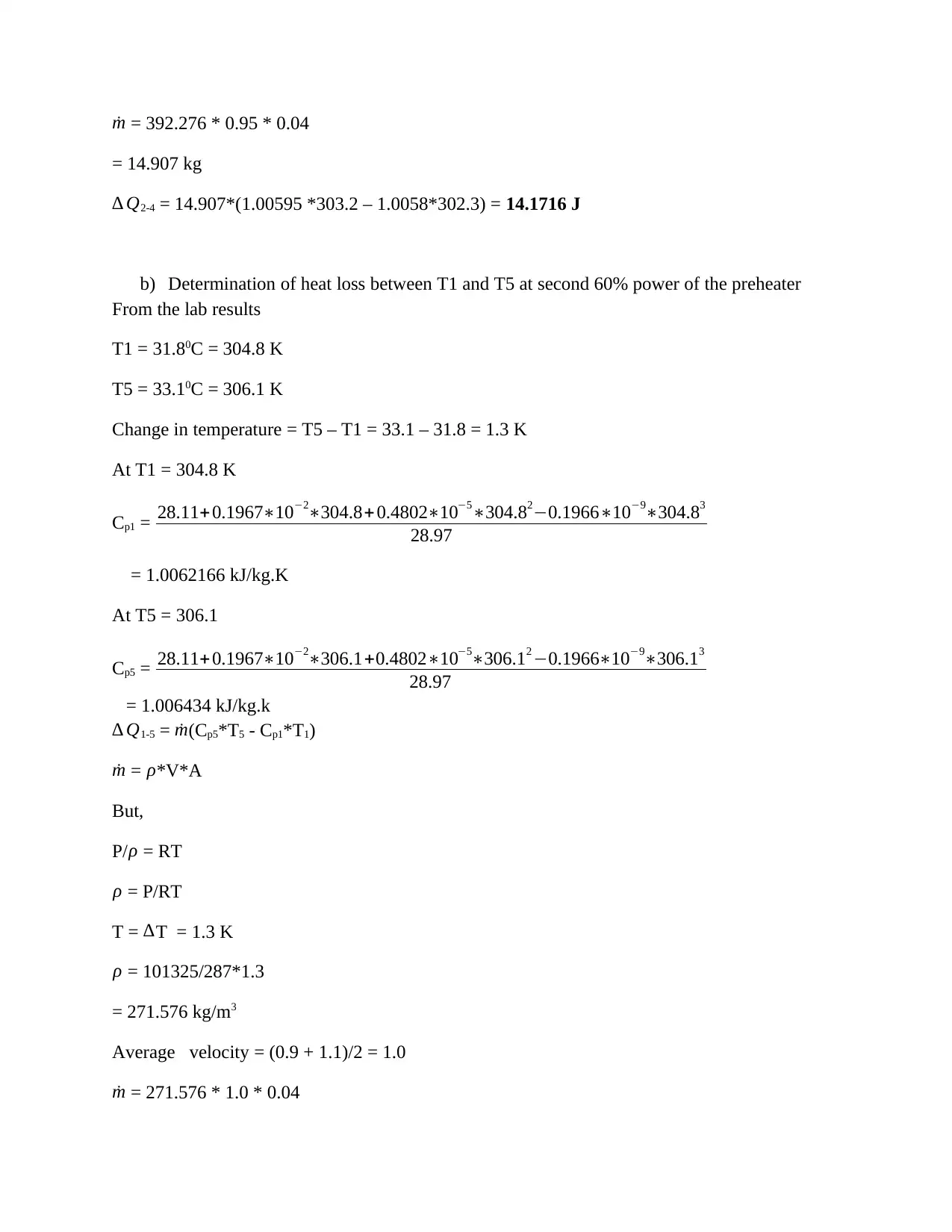
˙m = 392.276 * 0.95 * 0.04
= 14.907 kg
∆ Q2-4 = 14.907*(1.00595 *303.2 – 1.0058*302.3) = 14.1716 J
b) Determination of heat loss between T1 and T5 at second 60% power of the preheater
From the lab results
T1 = 31.80C = 304.8 K
T5 = 33.10C = 306.1 K
Change in temperature = T5 – T1 = 33.1 – 31.8 = 1.3 K
At T1 = 304.8 K
Cp1 = 28.11+0.1967∗10−2∗304.8+ 0.4802∗10−5∗304.82−0.1966∗10−9∗304.83
28.97
= 1.0062166 kJ/kg.K
At T5 = 306.1
Cp5 = 28.11+ 0.1967∗10−2∗306.1+0.4802∗10−5∗306.12 −0.1966∗10−9∗306.13
28.97
= 1.006434 kJ/kg.k
∆ Q1-5 = ˙m(Cp5*T5 - Cp1*T1)
˙m = ρ*V*A
But,
P/ρ = RT
ρ = P/RT
T = ∆T = 1.3 K
ρ = 101325/287*1.3
= 271.576 kg/m3
Average velocity = (0.9 + 1.1)/2 = 1.0
˙m = 271.576 * 1.0 * 0.04
= 14.907 kg
∆ Q2-4 = 14.907*(1.00595 *303.2 – 1.0058*302.3) = 14.1716 J
b) Determination of heat loss between T1 and T5 at second 60% power of the preheater
From the lab results
T1 = 31.80C = 304.8 K
T5 = 33.10C = 306.1 K
Change in temperature = T5 – T1 = 33.1 – 31.8 = 1.3 K
At T1 = 304.8 K
Cp1 = 28.11+0.1967∗10−2∗304.8+ 0.4802∗10−5∗304.82−0.1966∗10−9∗304.83
28.97
= 1.0062166 kJ/kg.K
At T5 = 306.1
Cp5 = 28.11+ 0.1967∗10−2∗306.1+0.4802∗10−5∗306.12 −0.1966∗10−9∗306.13
28.97
= 1.006434 kJ/kg.k
∆ Q1-5 = ˙m(Cp5*T5 - Cp1*T1)
˙m = ρ*V*A
But,
P/ρ = RT
ρ = P/RT
T = ∆T = 1.3 K
ρ = 101325/287*1.3
= 271.576 kg/m3
Average velocity = (0.9 + 1.1)/2 = 1.0
˙m = 271.576 * 1.0 * 0.04

= 10.863 kg
∆ Q2-4 = 10.863*(1.006434 *306.1 – 1.0062166*304.8) = 14.9326 J
c) Determination of heat loss between T5 and T4 at first 40% power of the preheater
From the lab results
T4 = 32.60C = 305.6 K
T5 = 30.20C = 303.2 K
Change in temperature = T4 – T5 = 32.6 – 30.2 = 2.4 K
At T4 = 305.6 K
Cp4 = 28.11+0.1967∗10−2∗305 .6+0.4802∗10−5∗305.62−0.1966∗10−9∗305.63
28.97
= 1.006323 kJ/kg.K
At T5 = 303.2
Cp5 = 28.11+ 0.1967∗10−2∗303.2+0.4802∗10−5∗303.22 −0.1966∗10−9∗303.23
28.97
= 1.00595 kJ/kg.k
∆ Q1-5 = ˙m(Cp4*T4 - Cp5*T5)
˙m = ρ*V*A
But,
P/ρ = RT
ρ = P/RT
T = ∆T = 2.4 K
ρ = 101325/287*2.4
= 147.104 kg/m3
Average velocity = (0.9 + 1.0)/2 = 0.95
˙m = 147.104 * 0.95 * 0.04
= 5.5899 kg
∆ Q2-4 = 10.863*(1.006434 *306.1 – 1.0062166*304.8) = 14.9326 J
c) Determination of heat loss between T5 and T4 at first 40% power of the preheater
From the lab results
T4 = 32.60C = 305.6 K
T5 = 30.20C = 303.2 K
Change in temperature = T4 – T5 = 32.6 – 30.2 = 2.4 K
At T4 = 305.6 K
Cp4 = 28.11+0.1967∗10−2∗305 .6+0.4802∗10−5∗305.62−0.1966∗10−9∗305.63
28.97
= 1.006323 kJ/kg.K
At T5 = 303.2
Cp5 = 28.11+ 0.1967∗10−2∗303.2+0.4802∗10−5∗303.22 −0.1966∗10−9∗303.23
28.97
= 1.00595 kJ/kg.k
∆ Q1-5 = ˙m(Cp4*T4 - Cp5*T5)
˙m = ρ*V*A
But,
P/ρ = RT
ρ = P/RT
T = ∆T = 2.4 K
ρ = 101325/287*2.4
= 147.104 kg/m3
Average velocity = (0.9 + 1.0)/2 = 0.95
˙m = 147.104 * 0.95 * 0.04
= 5.5899 kg
⊘ This is a preview!⊘
Do you want full access?
Subscribe today to unlock all pages.

Trusted by 1+ million students worldwide
1 out of 20
Related Documents
Your All-in-One AI-Powered Toolkit for Academic Success.
+13062052269
info@desklib.com
Available 24*7 on WhatsApp / Email
![[object Object]](/_next/static/media/star-bottom.7253800d.svg)
Unlock your academic potential
Copyright © 2020–2025 A2Z Services. All Rights Reserved. Developed and managed by ZUCOL.



